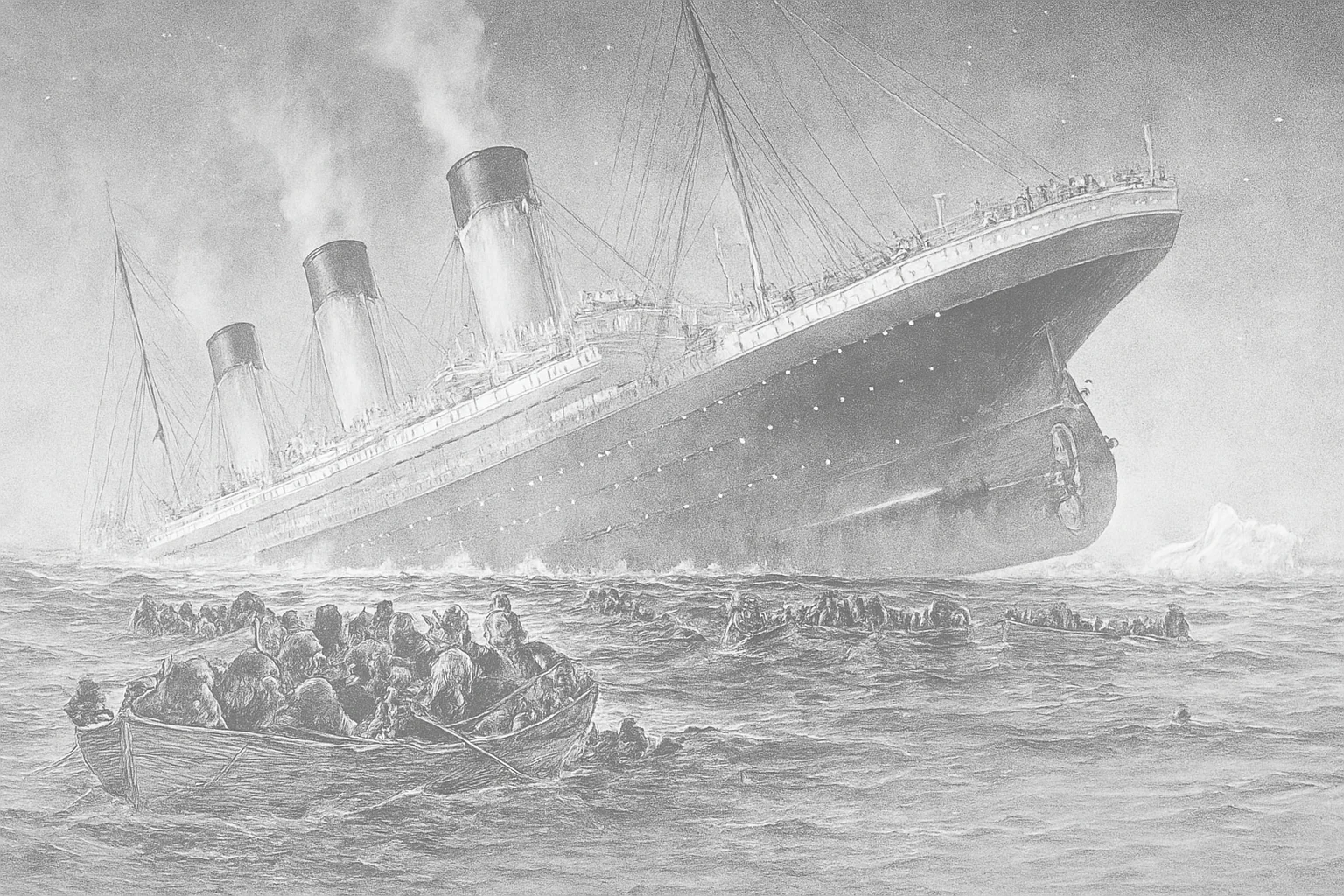
The Sinking of the RMS Titanic
by: The Calamity Calendar Team
April 14, 1912
In the world of transatlantic travel, the RMS Titanic was a symbol of human achievement at the dawn of the 20th century. Lauded as unsinkable, this grand vessel's maiden voyage began with much fanfare, only to end in unfathomable tragedy. The tale of the Titanic is one of technological wonder met by the sobering reminder of nature’s power.
Setting Sail: The Birth of a Legend
On April 10, 1912, the RMS Titanic embarked on what was supposed to be an unobservable journey into the annals of history. With decks abuzz and steam-billowing stacks cutting across a clear sky, the Titanic set sail from Southampton, England. The journey’s course was set to New York City, a cosmopolitan heart of the New World, promising new opportunities for its passengers.
This colossal ship, operated by the White Star Line, was compared to a floating city, boasting luxury accommodations, including a swimming pool, gymnasium, and even a squash court. Designed to accommodate 2,224 passengers and crew, it soon revealed a roster as varied as the ages: from the well-heeled elites reveling in first-class opulence to emigrants packed in steerage, each with dreams of a new life.
The 'Unsinkable' Irony
As the Titanic glided across the water, its reputation for invincibility preceded it. Crafted with a double bottom and divided into 16 watertight compartments, many sincerely believed that not even the fiercest Atlantic tempest could breach its defenses. Moreover, the public trust was bolstered by its advanced safety features, including doors that could shut remotely in case of an emergency. In the eyes of many, these engineering feats made it the safest ship afloat—yet, the battle between hubris and reality began to take shape with a deadly consequence.
The Iceberg Approaches
By the evening of April 14, the Titanic was steaming swiftly through icy waters, approximately 370 miles south-southeast of Newfoundland. It was here the watchmen’s vigilance became vital. The North Atlantic was known for its treacherous icebergs, which were especially prevalent after a harsh winter. As a testament to this danger, several ice warnings were issued throughout that fateful day. However, amidst the clamor of confidence, these signals were not coupled with the appropriate caution.
At approximately 11:40 PM, the looming disaster materialized. From the crow’s nest, the ominous silhouette of an iceberg was spotted dead ahead. The urgent warnings came too late for the Titanic to alter course significantly. The ocean colossus grazed the iceberg on its starboard side, inflicting what appeared to be a glancing blow. But below the waterline, it tells a different story as the liner staggered in its stride.
Thanks for subscribing!
The Icy Embrace
Beneath the waves, the iceberg’s impact tore a series of openings in the hull. Water cascaded into the forward compartments, breaching the unsinkable myth with unforgiving force. Distress signals soon crackled through the telegraphs: CQD and the newly established SOS were sent into the void, seeking aid from ships that lay just beyond the horizon.
As April 15’s early hours crept in, the order was given to prepare lifeboats. The Titanic was equipped with lifeboats for just a fraction of those aboard—a tragic oversight as desperation unfolded. Women and children were hustled into the boats, leaving behind real-life heroes like J. Bruce Ismay, whose presence became controversial, and Captain Edward Smith, who ostensibly chose to go down with his ship.
As clocks ticked toward the 2:00 AM mark, ordered chaos gripped the decks. Hearts raced as the “unsinkable” ship began its gradual dip beneath the inky surface. The last lifeboat was launched at 2:05 AM; five minutes later, the Titanic’s lights flickered out, yielding to the chilling moonlit silence.
Plunge into Obscurity
At precisely 2:20 AM, the Titanic succumbed to the sea, breaking apart with a final groan of steel. Clothing, deck chairs, and wood paneling bobbed on the surface, alongside anguished survivors grappling with hypothermia.
The RMS Carpathia, by then steaming at maximum speed towards the distress calls, arrived only in time to pluck the fortunate from lifeboats—a total of approximately 705 in number. Many, from steerage passengers to iconic figures like John Jacob Astor IV, were lost to the icy depths, and names of bravery, cowardice, and humanity were cast into the public consciousness.
Ripples Across the World
The incredulous shock of Titanic’s demise spread rapidly. Media outlets plastered headlines, sparking global mourning and outrage. Public inquiry led to lasting maritime reforms, most notably improved lifeboat standards and the establishment of the International Ice Patrol to keep the Atlantic seaways safer.
For the White Star Line, the tragedy invited both financial devastation and unwelcome scrutiny. As years passed and divers explored the Titanic’s resting place, a preserved testament emerged, an eerie monument to mankind’s foibles.
Titanic’s Enduring Legacy
Descendants of survivors, maritime historians, and curious minds alike have since been drawn to the Titanic's story. The tale of this sumptuous steamer endures beyond mere facts, permeating pop culture and stirring imaginations worldwide.
When Robert Ballard located the Titanic in 1985 lying in its watery grave some 12,500 feet below, he rekindled public fascination. Artifacts recovered from the wreck have since told intimate stories—the lost, whose lives once brimmed with future promise, found eternal peace amidst their ocean crypt.
The Titanic rests now, frozen in time, whispering the dangers of a navigated overconfidence. Her tale is etched in maritime legend, reminding us that even marvels built on engineering might can succumb to nature’s mighty will.
Stay in the Loop!
Become a Calamity Insider and get exclusive Calamity Calendar updates delivered straight to your inbox.
Thanks! You're now subscribed.